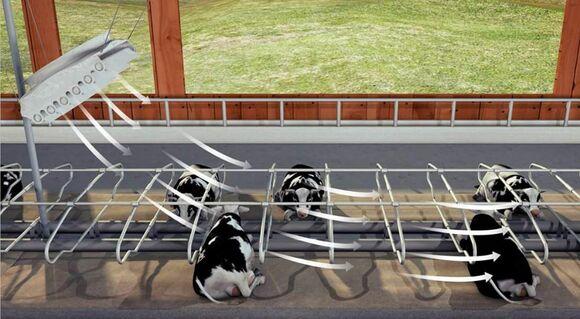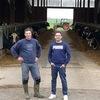Explore all the information on
Heat stress in dairy cattle
Welcome to the page about Heat stress in dairy cattle of Engormix; a source of knowledge on Heat stress in dairy cattle.
Summer heat stress is currently one of the biggest causes of economic losses to the global dairy industry, especially in the hot regions of the world. The International Dairy Federation (IDF) decided to deal with the problem and established recently an expert's committee to examine the issue and recommend ways to deal with it at the global level. After being recommended by the Israeli Dairy Board to participate in this committee, I found myself serving in a central role in...
Comments : 0
Recommendations: 2
INTRODUCTION The profitability of dairy farms is an increasing concern in many economies around the world (Ellis et al., 2020; Ojo et al., 2020). This is the result of continuous economic, political, social, and environmental factors affecting different countries and regions (O’Leary et al., 2018; Ramsbottom et al., 2021). Therefore, dairy farmers are continuously searching and updating strategies and technologies that can improve the dairy farm technical and economic...
Comments : 0
Recommendations: 1
We are back at the Real Science Exchange and invite you to pull up a chair and join us to discuss the effects of heat stress on late gestation cows. Dr. Geoff Dahl with the University of Florida and Dr. Jimena Laporta with the University of Wisconsin-Madison, join Scott Sorrell and Dr. Clay Zimmerman. ...
Comments : 2
Recommendations: 2
An article dealing with this topic was recently published in the prestigious journal of the dairy industry, Journal of Dairy Science (Espinoza-Sandoval et. al., JDS 106: 2023). The article examines, using a statistical model, the feasibility of investing in cooling the cows in the summer in various countries around the Mediterranean Sea (Europe, North Africa and the Middle East), where there are different “climate zones” regarding dairy farming. The model presented in this...
Comments : 0
Recommendations: 0


A case to be made for choline as a required nutrient for transition dairy cows
Suggested link
When talking about the negative impact of heat stress on milk production, we usually refer to the impact on milk volume (liters per cow per day or per lactation). The reality is that this is only part of the problem, which causes economic losses to farmers and dairy industry. As will be presented in this article, heat stress negatively affects milk fat and protein content and reduce milk quality, by increasing milk Somatic Cell Count (SCC) and bacterial count. In some cases, especially in...
Comments : 1
Recommendations: 3
This is how TOPCOOL VHV/CYCLONE fans work to make sure evenly distribution of airs on cubicles to maximise resting time ....
Comments : 1
Recommendations: 0
Heat stress related production loss, compromised welfare and cattle mortality are global concerns, which are increasing in the context of climate change and increase productivity of the cows. Cattle response to heat stress varies, based on individuality and thermal environment. In this article I intend to describe heat stress monitoring, in individual and herd basis, making use of thermal indices, as well as physiological and behavioral changes occurring in the heat stressed cow. 1....
Comments : 0
Recommendations: 2
Heat stress related production loss, compromised welfare and cattle mortality are global concerns which are increasing in the context of climate change and global warming. To maintain the welfare and performance of livestock, monitoring the effects of climatic extremes is important. Farming systems are becoming increasingly automated and remote/automated monitoring of animals is an ultimate need to overcome the limitations of human observation for continuous characterization of cows...
Comments : 0
Recommendations: 0
In mid-June this year, I realized a professional visit to Spain, where I lectured at a national conference organized by one of the country’s most popular dairy newspaper, Vaca Pinta, followed by a week of lecturing and consultancy for large scale dairy farms with MSD, realized in different regions of Spain. Among the visited regions were Talavera, south of Madrid, Galicia, in the northwest of the country, in the Atlantic coast and then the regions close to the cities of Girona and...
Comments : 2
Recommendations: 0
Israel is located in the eastern basin of the Mediterranean Sea and is characterized by a subtropical climate. Summer lasts from June to October and is characterized in most regions of the country by high temperatures and humidity at all hours of the day, but no rain at all. The Israeli dairy industry has about 120,000 cows that produce close to 1.5 billion liters per year. The annual milk yield per cow is the highest in the world and stood at more than 12,000 liters in 2021. The...
Comments : 2
Recommendations: 1


A case to be made for choline as a required nutrient for transition dairy cows
Suggested link
This article is written at the end of July, the hottest part of the year here in Israel, when every return home from abroad is first accompanied by going to the fridge to drink a lot of cold water. I decided that this is the right time to write about the importance of water in the dairy farm, especially for those located in warm regions. The issue of water in the dairy farm is an essential element in achieving milk yield, production efficiency and high profitability, especially in the warm...
Comments : 2
Recommendations: 4
An increase in the velocity of air, at a temperature lower than the surface temperature of the animal, has the potential to increase the sensible heat loss of the animal. An augmentation in air velocity will shift the upper critical temperature upwards. An effective ventilation system to reduce heat stress should emphasize the production of high air speed as much as the commonly accepted goal of reducing ambient temperature. Increasing the air velocity lowers the effective temperature...
Comments : 1
Recommendations: 1
Dr. Flamenbaum is a world-renowned agriculturist, bringing over four decades of expertise to the field of dairy cattle – specializing in strategic planning of dairy projects in warm climates, with emphasis on the relief of heat stress. ...
Comments : 1
Recommendations: 1
NiaShure™ is rumen-protected niacin that helps lower internal body temperature; protecting milk production and reproductive performance during the hot summer months. ...
Comments : 1
Recommendations: 2
In a previous article published some years ago here, dealing with cooling project that I accompanied in northern Mexico, I described the results from the first and second years of its implementation. The data were presented in a limited way, for a series of dairy farms belonging to the "Alpura" dairy cooperative, located in the warm regions of northern Mexico and characterized by long summer months, with extreme heat load conditions for dairy cows. These farms are mainly large and...
Comments : 3
Recommendations: 2
In a previous article that I recently published, I dealt with the importance of drinking water and water for cooling the cows, when dealing with the summer heat. In this article, I would like to deal with another factor that I see as very important in the above-mentioned confrontation, and it is shade, or in other words, preventing the exposure of cows to direct and indirect solar radiation in the summer. Why is it important to protect cows from solar radiation in the summer? To...
Comments : 1
Recommendations: 1


A case to be made for choline as a required nutrient for transition dairy cows
Suggested link
Introduction Milk production losses in summer months are generally related to the negative impact of heat stress on cows in lactation and late gestation stages. In the last 4 decades, several studies have been carried out in different parts of the world to mitigate heat through the implementation of cooling systems. In recently published articles, the different benefits achieved by properly implementing these means were presented. Among these benefits can be seen those related...
Comments : 0
Recommendations: 1
Heat stress can have a huge impact on all cows; reducing dry matter intake, suppressing immune responses and decreasing reproductive performance. Dr. Geoff Dahl takes a closer look at how heat stress affects late gestation cows and the additional toll heat stress takes on the resulting calf. ...
Comments : 0
Recommendations: 0
NiaShure is rumen-protected to shield the niacin from microbial degradation in the rumen while allowing release further down the digestive tract. Research shows that as much as 95% of raw niacin is broken down in the rumen. Balchem’s proprietary encapsulation process ensures that NiaShure reliably delivers significantly more niacin to the intestinal tract than raw niacin. ...
Comments : 0
Recommendations: 2
The dairy industry is important for economic and food security in most countries of the world. Millions of producers around the world raise about 280 million dairy cows and produce close to a billion tons of milk a year. Global economic expansion in the last fifty years is reflected in lifestyle changes in many countries, which are also reflected in the increase in demand for milk and its products, and this is especially true for “emerging countries”. Global milk consumption is...
Comments : 0
Recommendations: 4








.jpg&w=3840&q=75)







